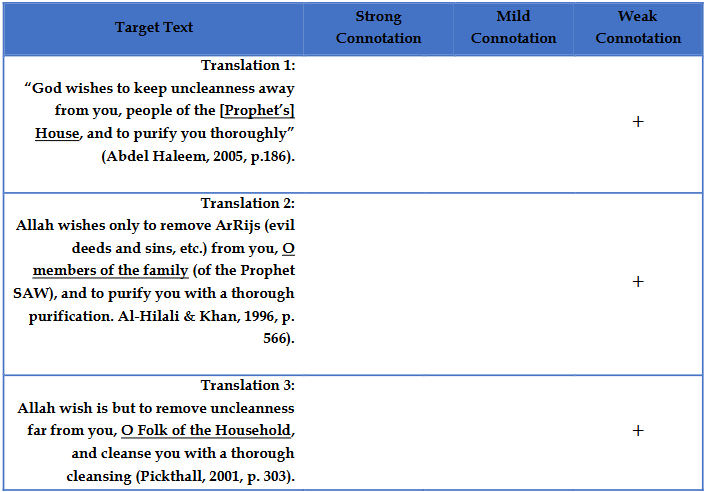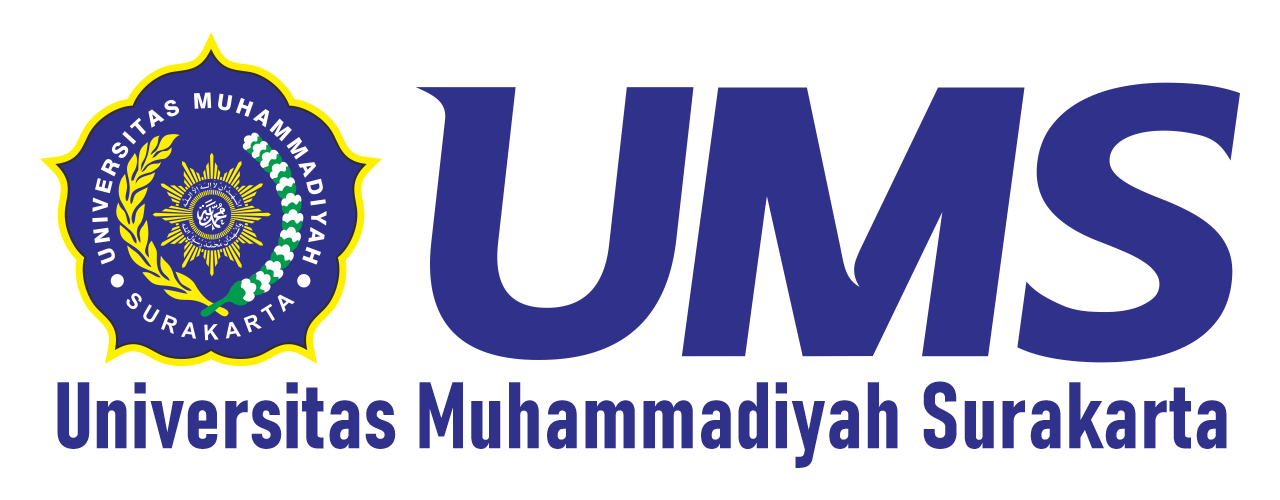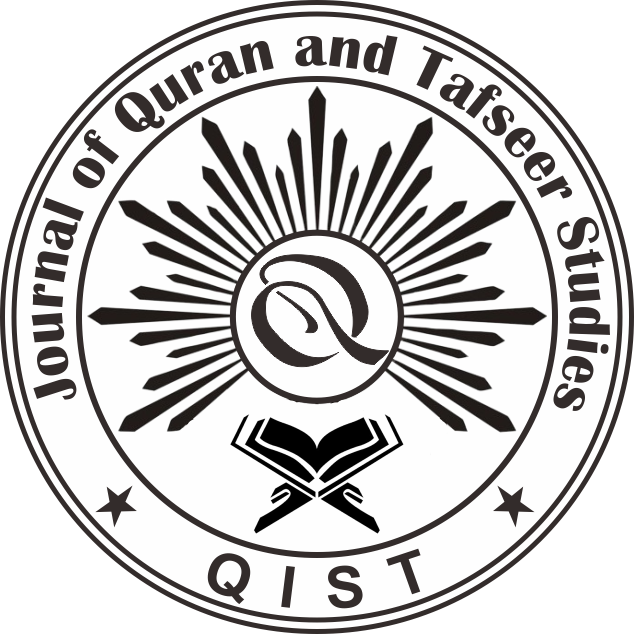TRANSLATING AYAHS ALEUDUL العدول IN THE QURANIC CONTEXTS: AN INTERDISCIPLINARY JURISPRUDENTIAL LINGUISTIC STUDY
DOI:
https://doi.org/10.23917/qist.v3i2.3542Keywords:
Ayahs Aleudul العدول, Quranic Contexts, Jurisprudential, Interdisciplinary, TranslatingAbstract
The current research paper aims to critically study translating Ayahs Aleudul العدول in the Quranic contexts from an interdisciplinary jurisprudential linguistic perspective. The findings of the study showed that Aleudul العدول in the Qur'anic context is a phenomenon that reoccurs in many ayahs. The researcher selected one of the many: the Quranic Arabic Aleudul العدول in Ayah 33 of Surat al-Ahzab to explain the phenomenon and discuss it in detail. The study also showed that the Quranic Arabic Aleudul العدول came in the Qur'anic context to reveal the importance of the meaning to be explained in the context to which it is assigned. The foremost of the problems encountered by translators of the Holy Quran was the dearth of most exegesis relating to this recurring phenomenon in the Holy Qur'an. This is because exegesis is founded on the segmentation of the ayahs rather than a single ayah to determine their denotations and memorize the rulings from them only once.
References
Abdelaal, N. M., & Md Rashid, S. (2015). Semantic loss in the Holy Qur'an translation with special reference to Surah Al-Waqi'a (Chapter of The Event Inevitable). SAGE Open, 5(4), https://doi.org/10.1177/2158244015605880
Abdelkarim, M. B. A., & Alhaj, A. A. M. (2021) Euphemism in some Selected Prophetic Hadiths and their Translation Accuracy into English: A Stylistic Analysis. Studies, 9(2), 47-57.
Abdul-Raof, H. (2004). The Qur'an: limits of translatability. In S. Faiq, (Ed.), Cultural Encounters in Translation from Arabic, Multilingual Matters Ltd., Clevedon (pp. 91-106).
Abu-Mahfouz, A. (2011). Some issues in translating nouns in Abdullah Yusuf Ali's translation of the meanings of the Holy Quran.
Agliz, R. (2015). Translation of religious texts: Difficulties and challenges. Arab World English Journal (AWEJ) Special Issue on Translation, (4).
Ahmad, R. (2022). (Translating Qur'anic Stylistics (Al-I'jāz Al-Balāghī): A Study of Six English Translations of Sūrat Ṭāhā, (Unpublished Master's thesis).
Al-Alousi, M.(2000). Ruhal-Ma'ani. DarIhyaTurathAl-Arabi. Beirut, Lebanon. Alasbli, N. A. (2021). Translating Figurative Language in the Quran: An Analytical Study.
Alasmari, J., Watson, J. C., & Atwel, D. E. (2017). Using the Quranic Arabic Corpus for comparative analysis of the Arabic and English verb systems. International Journal on Islamic Applications in Computer Science and Technology, 5(3), 1-8.
Al-Balbakī, M. (1969/2000). Al-Mawrid: Kāmūs Injelīzī-'Arabā, cet. 2. Bayrūt Lubnān: Dār al- 'Alam lil Malayīn Lubnān.
Al-Farahidi, A. K. B. A., & bin Ahmed, H. (1980). Al-Ain, Investigation: Dr. Mahdi Makhzoumi, Dar Al-Rasheed Publishing, Baghdad.
Alhaj, A. A. M. (2022). The Cultural and Semantic Problems Encountered in Translating the Arabic Qur'anic-Specific Lexica" Alkyedالكَيْدُ" in Sūrat Yusuf into English. AWEJ for Translation & Literary Studies, 6(4).
Alhaj, A. A. M. (2022). The Phenomenon of (Un) translatability Dilemma of Translating the Qur'anic Heart Words into English in (Repentance) Sūrat Al-tawbah. AWEJ for Translation & Literary Studies, 6.
Alhaj, A. (2015). New Theory of the Holy Qur'an Translation: A Textbook for Advanced University Students of Linguistics and Translation. Anchor Academic Publishing (aap_verlag).
Al-Jabari, R. (2008). Reasons for the possible incomprehensibility of some verses of three translations of the meaning of the Holy Quran into English (Doctoral dissertation, University of Salford (United Kingdom)
Al-Ramahi, A. (2008). Sulh: A crucial part of Islamic arbitration. 08-45.
Al Safi, O. J. M., & Al-Hayali, A. S. D. (2021). Aspects of the Interpretation of The Qur'an with The Qur'an, According to The Ahl Al-Bayt. PalArch's Journal of Archaeology of Egypt/Egyptology, 18(08), 4935-4940.
Alsyaed, Khalil, M., Mohamed. (2020). Aleudul in Conjunction and its impact on the Implication, a study in the Holy Qur'an. Journal of the Faculty of Arabic Language, Suez Canal, 33(7), 7583-7634
Abu-Milha, K. Y. (2003). Scientific issues in the Holy Qur'an: the meaning and translation of verses relating to the creation of the universe (Doctoral dissertation, Durham University).
Agliz, R. (2015). Translation of religious texts: Difficulties and challenges. Arab World English Journal (AWEJ) Special Issue on Translation, (4).
Baalbaki, R. (2014). 3 Muǧannas (Semasiological) Lexica. In The Arabic Lexicographical Tradition (pp. 279-401). Brill.
Bakhti Al-Ayashi. (2020). The effect of verbal Aleudul and its Miraculousness in the Holy Qur'an. Al-Maqri Journal of Theoretical and Applied Linguistic Studies Volume 03 / Issue: (06) 2020, (pp. 49-63)
Bandia, P. (1993). Translation as culture transfer: Evidence from African creative writing. TTR: traduction, terminologie, rédaction, 6(2), 55-78.
Bedeker, L., & Feinauer, I. (2006). The translator is a cultural mediator. Southern African linguistics and applied language studies, 24(2), 133-141.
Benzehra, R. (2012). Issues and challenges for a modern English-Arabic dictionary. Dictionaries: Journal of the Dictionary Society of North America, 33(1), 83-102.
Bigdeli, H., Aghanouri, A., & Yousefi Gharavi, M. H. (2022). The role of Kumeyt ibn Zayd al-Asadi in spreading interest in the Ahl al-Bayt by emphasizing the ode. Journal of Imamiyyah Studies.
Diab, T. (Ed.). (2017). Pedagogical lexicography: A case study of Arab nurses as dictionary users (Vol. 31). Walter de Gruyter GmbH & Co KG.
Bielsa, E., & Kapsaskis, D. (Eds.). (2020). The Routledge handbook of translation and globalization. Routledge.
Elewa, A. (2014). Features of translating religious texts. Journal of Translation, 10(1), 25-33.
Fayyad, Hassan Hamid (2010). Aleudul in the Qur'anic context (In Arabic). Journal of the College of Jurisprudence. journal.uokufa.edu.iq
France, P. (Ed.). (2001). The Oxford guide to literature in English translation. Oxford University Press on Demand.
Hatim, B., & Munday, J. (2019). Translation: An advanced resource book for students. Routledge.
Heliel, M. H. (1987). Definitions of linguistic terms in an English-Arabic dictionary. Dictionaries: Journal of the Dictionary Society of North America, 9(1), 133-148.
Hidaya, M. S., & Solihin, S. M. (2019). Translatability of the Qur'an: An Analysis of Linguistic and Theological Elements. Islamic Insight, 2(1), 12-36.
Hunzai, F. M., Noormohamed-Hunzai, R., Karim, Y., & Lalani, Z. (2020). The Holy Ahl al-Bayt in the Prophetic Traditions. Sharon, M. (1986). Ahl al-bayt—People of the House. Jerusalem Studies in Arabic and Islam, 8(1), 169-84.
Ibn al-Athir. (1998). Al-Kamil fi al-Tarikh. (Vol. 1, 2, 3, 4, 5, 6, 7, 8, 9, 10, 11 & 12). Beirut: Dar al-Kitab al-'Ilmiah.
Ibn Manzoor, Jamal Al-Din Bin Mohammad Bin Mokarram Ibn Manzoor (630 AH/1232 AD-711 AH/1311 AD), "Lisan Al-Arab" Dictionary, verification by Abdullah Ali Al-kabeer, Mohammad Ahmad Hasab Allah, Hashem Mohammad Al-Sh.
Kamaruzaman, A. F., Jamaludin, N., & Fadzil, A. F. M. (2015). Ibn Al-Athir's Philosophy of History in Al-Kamil Fi Al-Tarikh. Asian Social Science, 11(23), 28.
Koçak, A. Y. (2002). Handbook of Arabic dictionaries. Verlag Hathleticheli, "Dar Al-Ma`aref" Publishing, Cairo.
Mahdi, A. S. (2021). Proverbs in the dictionary of the arbitrator and the Great Ocean-Analytical linguistic study. College Of Basic Education Research Journal, 17(4), 94-143.
Micheau, F. (2014). Ibn al-Athīr. In Medieval Muslim historians and the Franks in the Levant (pp. 52-83). Brill.
Mollanazar, H., & Mohaqeq, S. M. (2005). The Holy Qur'an: Translation and Ideological Presuppositions. Translation Studies Quarterly, 3(11).
Muhammed, Zahida Abdullah (2008) Deviating from the context in the Holy Quran Study in (singular, dual and plural) JOURNAL OF EDUCATION AND SCIENCE, 2008, Volume 15, Issue 30, Pages 110-131,
Nida, E. A. (1994). The sociolinguistics of translating canonical religious texts. TTR: traduction, terminologie, redaction, 7(1), 191-217.
Qarai, A. (2021). The Qur'an: With a Phrase-by-Phrase English Translation. Qarai.Recalling Ahl al-Bayt (peace be upon them) and the Symbolic Functions of this in the Poems of Nazzar Ghabbani. Research Quarterly of Shia Literature, 1(1), 140-12.
Robinson, D. (2000). Sacred texts. In FRANCE, P. The Oxford guide to literature in English translation. Oxford: Oxford University Press, 2000, pp. 103–107.
Saadi,Hassan Ghazi Akrouk Saadi. (2021). The Significance of the Phonetic Aleudul by the addition of the Holy Quran Journal of University of Babylon, 2020, Volume 28, Issue 2, Pages 313-320.
Sattar, Hussain Khudair (2006) Aleudul in the Context of Conjunction in the Quranic Text.The University of Thi-Qar Journal. Volume 2, Issue 2, Pages 1-8.
Siepmann, D. (2005). Discourse markers across languages: A contrastive study of second-level discourse markers in native and non-native text with implications for general and pedagogic lexicography (Vol. 6). Psychology Press.
Tymoczko, M. (2003). Ideology and the Position of the Translator. Apropos of Ideology: Translation studies on ideology-ideologies in translation studies, 182-200.
Wimbush, V. L. (Ed.). (2008). Theorizing scriptures: new critical orientations to a cultural phenomenon. Rutgers University Press.
Wolf, M. (1997). Translation as a process of power: Aspects of cultural anthropology in translation.
Abdelaal, Noureldin Mohamed, and Sabariah Md Rashid. "Semantic Loss in the Holy Qur'an Translation With Special Reference to Surah Al-W a QiAAa (Chapter of The Event Inevitable )." SAGE Open 5, no. 4 (October 1, 2015): 215824401560588. https://doi.org/10.1177/2158244015605880.
Abdoulaye, Bamba, Yahya Fathur Rozy, and Ahmadou Siendou Konate. "MUHAMMAD IBN ABDUL WAHHAB'S PERSPECTIVE ABOUT THE VERSES OF THE QUR'AN REGARDING THE SCIENCE OF THEOLOGY." QiST: Journal of Quran and Tafseer Studies 3, no. 1 (December 15, 2023): 57–74. https://doi.org/10.23917/qist.v3i1.2913.
Abulmajd, Abdurrahman. "WHAT IS THE MODEL OF MUSLIM RELATIONS WITH THE KAABA FROM THE PERSPECTIVE OF THE QUR'AN." QiST: Journal of Quran and Tafseer Studies 3, no. 1 (December 16, 2023): 107–45. https://doi.org/10.23917/qist.v3i1.3583.
AN, Andri Nirwana. "أصول التفسير عند عبد الله بن عمر رضي الله عنهما في تفسير القرآن." JURNAL ILMIAH PEURADEUN 2, no. 2 (2014): 161–90. https://journal.scadindependent.org/index.php/jipeuradeun/article/view/30.
An, Andri Nirwana, Muhammad Yusri Alfian, Saifudin, and Sayed Akhyar. "Implementasi Metode Tafsir Tahlili Terhadap Qs Ar-Rum Ayat 30 Tentang Fitrah Manusia Dalam Tafsir Azhar Untuk Membendung Embrio Paham Atheis." Jurnal Ilmu Al Quran Dan Tafsir 6, no. 2 (2021).
An, Andri Nirwana, Ahmad Nurrohim, Ilham Jimly, Ash Shiddiqi, Muhammad Azizi, Muhammad Agus, Tifanni Lovely, Ibnu Mas'ud, and Sayed Akhyar. "Pelatihan Metode Tajdied Untuk Peningkatan Membaca Al-Qur'an Siswa SD Muhammadiyah Program Khusus Kottabarat (Tajdied Method Training to Improve Al-Qur'an Reading for Muhammadiyah Elementary School Students Kottabarat Special Program)." Jurnal PEMA Tarbiyah 50, no. 1 (2023): 50–68. http://jurnaltarbiyah.uinsu.ac.id/index.php/pematarbiyah.
Chege, Kirongo, and Odoyo Otieno. "Research Philosophy Design and Methodologies: A Systematic Review of Research Paradigms in Information Technology." Global Scientific Journals 8, no. 5 (2020).
Fadli, Nazar. "CONTRIBUTION OF ACEHNESE SCHOLARS TO THE DEVELOPMENT OF QURANIC EXEGESIS IN INDONESIA: A STUDY OF TENGKU MUHAMMAD HASBI ASH-SHIDDIEQY AND HIS WORK 'TAFSIR AN-NUUR.'" QiST: Journal of Quran and Tafseer Studies 3, no. 1 (December 5, 2023): 1–22. https://doi.org/10.23917/qist.v3i1.3381.
Haleem, M A Abdel. The Qur'an. OUP Oxford, 2005.
Kawthar, Surah. "Tafsîr Ibn Kathîr," 2000.
Nirwana AN, Andri. "Qawaid Tafsir Dan Ushul Tafsir Siti Aisyah Dalam Kitab Sahih Muslim." Jurnal Ilmiah Al-Mu'ashirah 18, no. 2 (November 19, 2021): 152. https://doi.org/10.22373/jim.v18i2.11281.
Nirwana AN, Andri, and Syardan Jalil. "QURANICPRENEUR: INNOVATION OF THE NEURO NADI METHOD TOWARDS LEARNING OF THE QUR'AN IN BANDA ACEH." PROCEEDINGS: Dirundeng International Conference on Islamic Studies, May 31, 2022, 165–74. https://doi.org/10.47498/dicis.v1i1.1022.
Nirwana, Andri. "DA'WAH IN THE QUR'AN (THEMATIC TAFSIR)." Jurnal At-Tibyan: Jurnal Ilmu Alqur'an Dan Tafsir 4, no. 2 (December 16, 2019): 307–29. https://doi.org/10.32505/tibyan.v4i2.1350.
Nirwana, Andri, M Darojat Ariyanto, Muh Fuad Abror, Sayed Akhyar, and Faisal bin Husen Ismail. "SEMANTIC ANALYSIS OF WHERE IS THE DIFFERENCE IN THE MEANING OF THE WORDS QALB AND FUĀD IN THE QUR'AN?" Jurnal STIU Darul Hikmah 9, no. 1 (March 28, 2023): 12–20. https://doi.org/10.61086/jstiudh.v9i1.38.
Nirwana, Andri, Ainal Fitri, Rahmadon Rahmadon, Fahmi Arfan, Zahari Zahari, and Fitri Meliya Sari. "Sosialisasi Kemukjizatan Al Qur'an Terhadap Komunitas Pendengar Radio Baiturrahman Aceh Melalui Program Interaktif Al Qur'an Dan Sains." PERDIKAN (Journal of Community Engagement) 1, no. 2 (December 31, 2019): 1–4. https://doi.org/10.19105/pjce.v1i2.2863.
Patel, Mimansha, and Nitin Patel. "Exploring Research Methodology: Review Article." International Journal of Research and Review 6, no. 3 (2019).
———. "Exploring Research Methodology." International Journal of Research and Review 6, no. 3 (2019).
Pickthall, Mohammed Marmaduke. The Meaning of the Glorious Quran. Islamic Cultural Centre, 2001.
Ridha, Ismu, Manshur Mahmud Abu Zinah, Muhibbul Subhi, and M. Nasir. "THE QUR'AN'S STATEMENT ABOUT THE ETIQUETTE OF DEALING WITH THE HOLY QUR'AN FROM SAYYID QUTB'S PERSPECTIVE IN HIS INTERPRETATION OF (ADH-DHILAL): AN ANALYTICAL STUDY." QiST: Journal of Quran and Tafseer Studies 3, no. 1 (December 13, 2023): 40–56. https://doi.org/10.23917/qist.v3i1.2874.
Romadhona, Azizah, Muhamad Subhi Apriantoro, and Laila Muhammad Rasyid. "EXPLORING THE DISTINCTIVE FEATURES OF INDONESIAN TAFSIR AL-QURAN: A STUDY OF SHEIKH ABDUL LATIF SYAKUR'S AD-DA'WAH WA AL-IRSYĀD ILĀ SABĪLI AR-RASYĀD." QiST: Journal of Quran and Tafseer Studies 3, no. 1 (December 16, 2023): 91–106. https://doi.org/10.23917/qist.v3i1.2912.
Rozy, Yahya Fathur, Yohei Matsuyama, and Dina Sijamhodžić-Nadarević. "THE DEVELOPMENT OF QUR'AN COMMENTATORS' REQUIREMENTS: FROM THE AFFIRMATIVE ERA TO THE REFORMATIVE ERA." QiST: Journal of Quran and Tafseer Studies 3, no. 1 (December 15, 2023): 75–90. https://doi.org/10.23917/qist.v3i1.2910.
Sule, Muhammad Maga. "RESPONSE TO MUSLIMS DA'WAH ACTIVITIES' BY NON-MUSLIMS IN AKWANGA AND NASSARAWA EGGON LOCAL GOVERNMENT AREAS OF NASARAWA STATE, NIGERIA." QiST: Journal of Quran and Tafseer Studies 3, no. 1 (December 5, 2023): 23–39. https://doi.org/10.23917/qist.v3i1.3110.

Downloads
Submitted
Accepted
Published
How to Cite
Issue
Section
License
Copyright (c) 2024 Ali Albashir Mohammed Alhaj

This work is licensed under a Creative Commons Attribution 4.0 International License.














